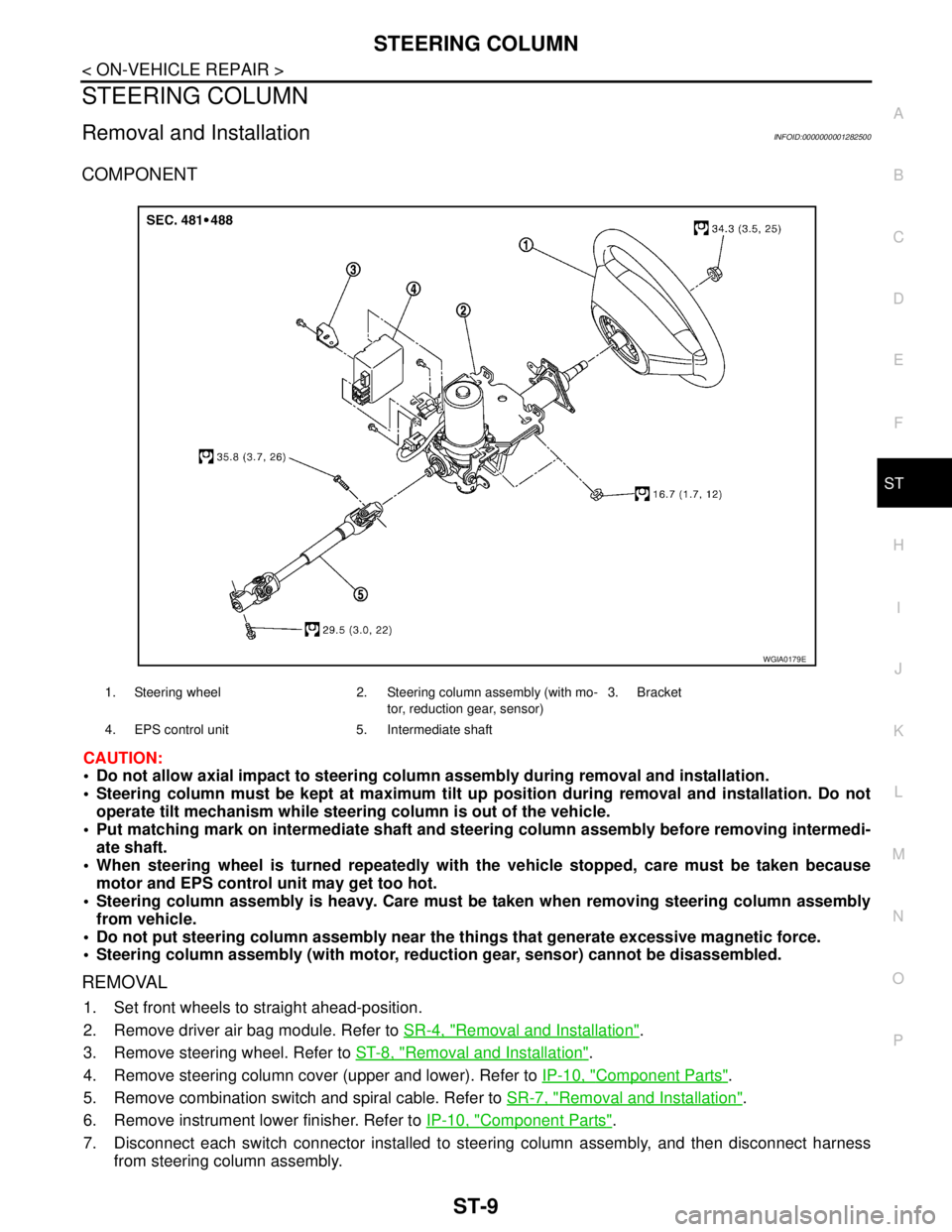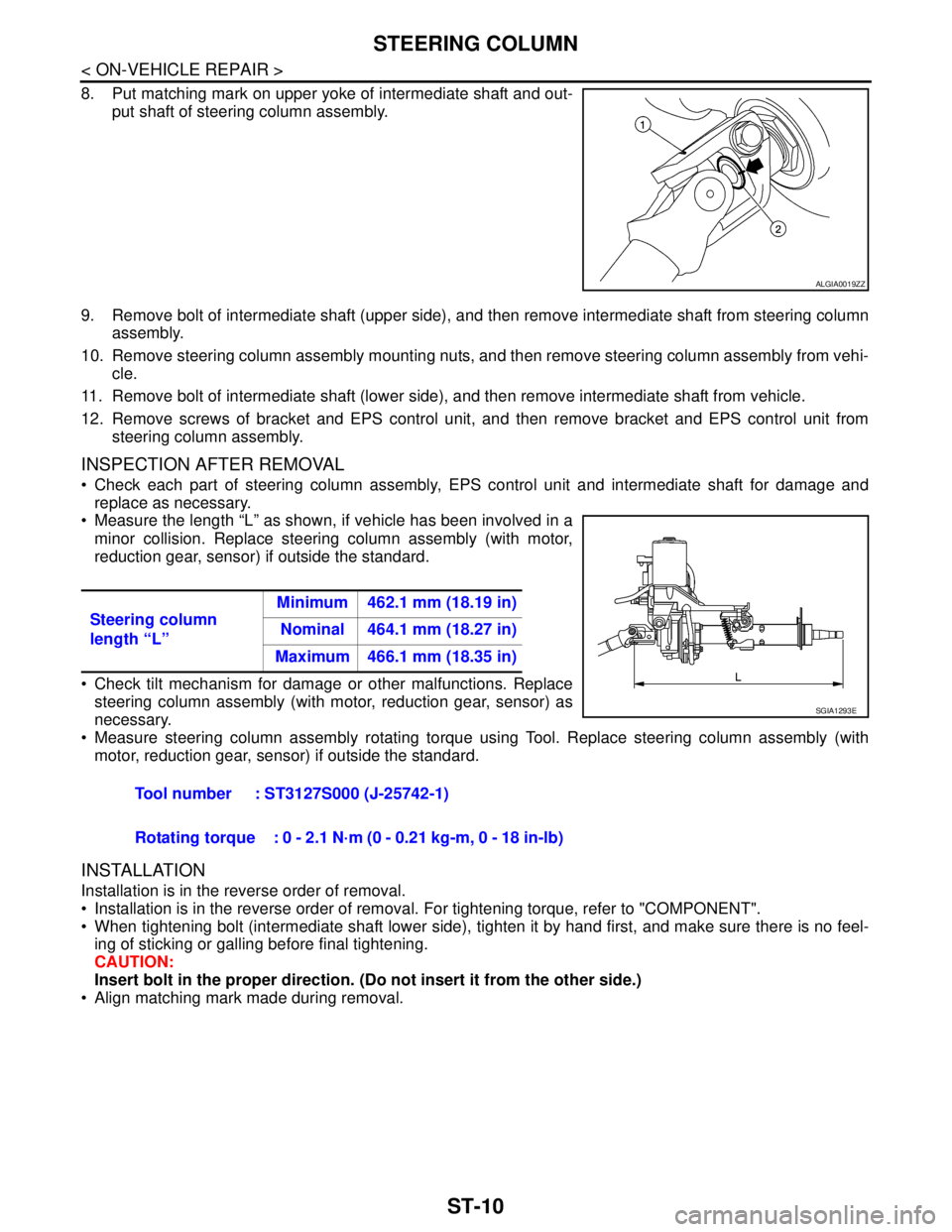2007 NISSAN TIIDA sensor
[x] Cancel search: sensorPage 4855 of 5883

SRC-86
< PRECAUTION >
PRECAUTIONS
PRECAUTION
PRECAUTIONS
Precaution for Supplemental Restraint System (SRS) "AIR BAG" and "SEAT BELT
PRE-TENSIONER"
INFOID:0000000001396424
The Supplemental Restraint System such as “AIR BAG” and “SEAT BELT PRE-TENSIONER”, used along
with a front seat belt, helps to reduce the risk or severity of injury to the driver and front passenger for certain
types of collision. Information necessary to service the system safely is included in the SR and SB section of
this Service Manual.
WARNING:
To avoid rendering the SRS inoperative, which could increase the risk of personal injury or death in
the event of a collision which would result in air bag inflation, all maintenance must be performed by
an authorized NISSAN/INFINITI dealer.
Improper maintenance, including incorrect removal and installation of the SRS, can lead to personal
injury caused by unintentional activation of the system. For removal of Spiral Cable and Air Bag
Module, see the SR section.
Do not use electrical test equipment on any circuit related to the SRS unless instructed to in this
Service Manual. SRS wiring harnesses can be identified by yellow and/or orange harnesses or har-
ness connectors.
Precaution for SRS "AIR BAG" and "SEAT BELT PRE-TENSIONER" Service
INFOID:0000000001396425
Do not use electrical test equipment to check SRS circuits unless instructed to in this Service Manual.
Before servicing the SRS, turn ignition switch OFF, disconnect both battery cables and wait at least 3 min-
utes.
For approximately 3 minutes after the cables are removed, it is still possible for the air bag and seat belt pre-
tensioner to deploy. Therefore, do not work on any SRS connectors or wires until at least 3 minutes have
passed.
The air bag diagnosis sensor unit must always be installed with the arrow mark “⇐” pointing toward the front
of the vehicle for proper operation. Also check air bag diagnosis sensor unit for cracks, deformities or rust
before installation and replace as required.
The spiral cable must be aligned with the neutral position since its rotations are limited. Do not attempt to
turn steering wheel or column after removal of steering gear.
Handle air bag module carefully. Always place driver and front passenger air bag modules with the pad side
facing upward and seat mounted front side air bag module standing with the stud bolt side facing down.
Conduct self-diagnosis to check entire SRS for proper function after replacing any components.
After air bag inflates, the front instrument panel assembly should be replaced if damaged.
Page 4864 of 5883

STEERING COLUMN
ST-9
< ON-VEHICLE REPAIR >
C
D
E
F
H
I
J
K
L
MA
B
ST
N
O
P
STEERING COLUMN
Removal and InstallationINFOID:0000000001282500
COMPONENT
CAUTION:
Do not allow axial impact to steering column assembly during removal and installation.
Steering column must be kept at maximum tilt up position during removal and installation. Do not
operate tilt mechanism while steering column is out of the vehicle.
Put matching mark on intermediate shaft and steering column assembly before removing intermedi-
ate shaft.
When steering wheel is turned repeatedly with the vehicle stopped, care must be taken because
motor and EPS control unit may get too hot.
Steering column assembly is heavy. Care must be taken when removing steering column assembly
from vehicle.
Do not put steering column assembly near the things that generate excessive magnetic force.
Steering column assembly (with motor, reduction gear, sensor) cannot be disassembled.
REMOVAL
1. Set front wheels to straight ahead-position.
2. Remove driver air bag module. Refer to SR-4, "
Removal and Installation".
3. Remove steering wheel. Refer to ST-8, "
Removal and Installation".
4. Remove steering column cover (upper and lower). Refer to IP-10, "
Component Parts".
5. Remove combination switch and spiral cable. Refer to SR-7, "
Removal and Installation".
6. Remove instrument lower finisher. Refer to IP-10, "
Component Parts".
7. Disconnect each switch connector installed to steering column assembly, and then disconnect harness
from steering column assembly.
1. Steering wheel 2. Steering column assembly (with mo-
tor, reduction gear, sensor)3. Bracket
4. EPS control unit 5. Intermediate shaft
WGIA0179E
Page 4865 of 5883

ST-10
< ON-VEHICLE REPAIR >
STEERING COLUMN
8. Put matching mark on upper yoke of intermediate shaft and out-
put shaft of steering column assembly.
9. Remove bolt of intermediate shaft (upper side), and then remove intermediate shaft from steering column
assembly.
10. Remove steering column assembly mounting nuts, and then remove steering column assembly from vehi-
cle.
11. Remove bolt of intermediate shaft (lower side), and then remove intermediate shaft from vehicle.
12. Remove screws of bracket and EPS control unit, and then remove bracket and EPS control unit from
steering column assembly.
INSPECTION AFTER REMOVAL
Check each part of steering column assembly, EPS control unit and intermediate shaft for damage and
replace as necessary.
Measure the length “L” as shown, if vehicle has been involved in a
minor collision. Replace steering column assembly (with motor,
reduction gear, sensor) if outside the standard.
Check tilt mechanism for damage or other malfunctions. Replace
steering column assembly (with motor, reduction gear, sensor) as
necessary.
Measure steering column assembly rotating torque using Tool. Replace steering column assembly (with
motor, reduction gear, sensor) if outside the standard.
INSTALLATION
Installation is in the reverse order of removal.
Installation is in the reverse order of removal. For tightening torque, refer to "COMPONENT".
When tightening bolt (intermediate shaft lower side), tighten it by hand first, and make sure there is no feel-
ing of sticking or galling before final tightening.
CAUTION:
Insert bolt in the proper direction. (Do not insert it from the other side.)
Align matching mark made during removal.
ALGIA0019ZZ
Steering column
length “L”Minimum 462.1 mm (18.19 in)
Nominal 464.1 mm (18.27 in)
Maximum 466.1 mm (18.35 in)
Tool number : ST3127S000 (J-25742-1)
Rotating torque : 0 - 2.1 N·m (0 - 0.21 kg-m, 0 - 18 in-lb)
SGIA1293E
Page 4875 of 5883

STC-1
STEERING
C
D
E
F
H
I
J
K
L
M
SECTION STC
A
B
STC
N
O
P
CONTENTS
STEERING CONTROL SYSTEM
EPS
BASIC INSPECTION ....................................
3
DIAGNOSIS AND REPAIR WORKFLOW ..........3
Work Flow .................................................................3
FUNCTION DIAGNOSIS ...............................4
EPS SYSTEM ......................................................4
System Diagram ........................................................4
System Description ...................................................4
Component Parts Location ........................................5
Component Description .............................................6
CAN Communication .................................................6
DIAGNOSIS SYSTEM (EPS CONTROL UNIT)
.....
7
CONSULT-III Function (EPS) ...................................7
COMPONENT DIAGNOSIS ..........................9
C1601 BATTERY POWER SUPPLY ..................9
Description ................................................................9
DTC Logic .................................................................9
Diagnosis Procedure .................................................9
Special Repair Requirement (Models with ESP) .....10
C1604 TORQUE SENSOR .................................11
Description ..............................................................11
DTC Logic ...............................................................11
Diagnosis Procedure ...............................................11
Special Repair Requirement (Models with ESP) .....12
C1606 EPS MOTOR ...........................................13
Description ..............................................................13
DTC Logic ...............................................................13
Diagnosis Procedure ...............................................13
Special Repair Requirement (Models with ESP) .....14
C1607 EEPROM .................................................15
Description ..............................................................15
DTC Logic ................................................................15
Diagnosis Procedure ...............................................15
Special Repair Requirement (Models with ESP) .....15
C1608 EPS CONTROL UNIT ............................16
Description ...............................................................16
DTC Logic ................................................................16
Diagnosis Procedure ...............................................16
Special Repair Requirement (Models with ESP) .....16
C1609 CAN VHCL SPEED ...............................17
Description ...............................................................17
DTC Logic ................................................................17
Diagnosis Procedure ...............................................17
Special Repair Requirement (Models with ESP) .....18
C1610 CAN ENG RPM ......................................19
Description ...............................................................19
DTC Logic ................................................................19
Diagnosis Procedure ...............................................19
Special Repair Requirement (Models with ESP) .....19
U1000 CAN COMM CIRCUIT ...........................21
Description ...............................................................21
DTC Logic ................................................................21
Diagnosis Procedure ...............................................21
Special Repair Requirement (Models with ESP) .....21
ECU DIAGNOSIS .........................................22
EPS CONTROL UNIT .......................................22
EPS Control Unit Input/Output Signal Reference
Value .......................................................................
22
Wiring Diagram - EPS - ...........................................24
Fail-Safe Function ...................................................27
DTC Index ...............................................................28
SYMPTOM DIAGNOSIS ..............................29
EPS SYSTEM SYMPTOMS ..............................29
Symptom Chart ........................................................29
Page 4878 of 5883
![NISSAN TIIDA 2007 Service Repair Manual STC-4
< FUNCTION DIAGNOSIS >[EPS]
EPS SYSTEM
FUNCTION DIAGNOSIS
EPS SYSTEM
System DiagramINFOID:0000000001697715
System DescriptionINFOID:0000000001697714
EPS CONTROL UNIT
• EPS control unit perform NISSAN TIIDA 2007 Service Repair Manual STC-4
< FUNCTION DIAGNOSIS >[EPS]
EPS SYSTEM
FUNCTION DIAGNOSIS
EPS SYSTEM
System DiagramINFOID:0000000001697715
System DescriptionINFOID:0000000001697714
EPS CONTROL UNIT
• EPS control unit perform](/manual-img/5/57395/w960_57395-4877.png)
STC-4
< FUNCTION DIAGNOSIS >[EPS]
EPS SYSTEM
FUNCTION DIAGNOSIS
EPS SYSTEM
System DiagramINFOID:0000000001697715
System DescriptionINFOID:0000000001697714
EPS CONTROL UNIT
• EPS control unit performs an arithmetical operation on data, such as steering wheel turning force (sensor
signal) from the torque sensor, vehicle speed signal, etc. Then it generates an optimum assist torque to the
EPS motor according to the driving condition.
EPS control unit decreases the output to EPS motor while extremely using the power steering function (e.g.,
full steering) for protecting EPS motor and EPS control unit (Protect overload status). While activating pro-
tect overload status, the assist torque gradually decreases, and the steering wheel turning force becomes
heavy. The normal assist torque reactivates by not steering.
In case of an error in the electrical system, the fail-safe function stops output signals to the EPS motor. Then
the previous state is changed to the manual steering state.
Self-diagnosis can be done with CONSULT-III.
EPS MOTOR
EPS motor provides the assist torque by control signal from EPS control unit.
TORQUE SENSOR
Torque sensor detects the steering torque, and transmit the signal to EPS control unit.
REDUCTION GEAR
Reduction gear increases the assist torque provided from EPS motor with worm gears, and outputs to the col-
umn shaft.
EPS WARNING LAMP
Turns ON when there is a malfunction in EPS system. It indicates that fail-safe mode is engaged and enters a
manual steering state (Control turning force steering wheel becomes heavy).
Also turns ON when ignition switch is turned ON, for purpose of lamp check. Turns OFF after the engine starts
if system is normal.
EPS Warning Lamp Indication
SGIA1649E
Condition EPS warning lamp
Lamp checkTurns ON when ignition switch is turned ON.
Turns OFF after engine start.
Page 4879 of 5883
![NISSAN TIIDA 2007 Service Repair Manual EPS SYSTEM
STC-5
< FUNCTION DIAGNOSIS >[EPS]
C
D
E
F
H
I
J
K
L
MA
B
STC
N
O
P
Component Parts LocationINFOID:0000000001697719
EPS system malfunctionON
Other than above (system normal) OFFCondition EPS NISSAN TIIDA 2007 Service Repair Manual EPS SYSTEM
STC-5
< FUNCTION DIAGNOSIS >[EPS]
C
D
E
F
H
I
J
K
L
MA
B
STC
N
O
P
Component Parts LocationINFOID:0000000001697719
EPS system malfunctionON
Other than above (system normal) OFFCondition EPS](/manual-img/5/57395/w960_57395-4878.png)
EPS SYSTEM
STC-5
< FUNCTION DIAGNOSIS >[EPS]
C
D
E
F
H
I
J
K
L
MA
B
STC
N
O
P
Component Parts LocationINFOID:0000000001697719
EPS system malfunctionON
Other than above (system normal) OFFCondition EPS warning lamp
1. EPS warning lamp 2. EPS control unit 3. EPS motor
4. Torque sensor 5. Reduction gear
AWGIA0027ZZ
Page 4880 of 5883
![NISSAN TIIDA 2007 Service Repair Manual STC-6
< FUNCTION DIAGNOSIS >[EPS]
EPS SYSTEM
Component Description
INFOID:0000000001716729
CAN CommunicationINFOID:0000000001697716
SYSTEM DESCRIPTION
CAN (Controller Area Network) is a serial commun NISSAN TIIDA 2007 Service Repair Manual STC-6
< FUNCTION DIAGNOSIS >[EPS]
EPS SYSTEM
Component Description
INFOID:0000000001716729
CAN CommunicationINFOID:0000000001697716
SYSTEM DESCRIPTION
CAN (Controller Area Network) is a serial commun](/manual-img/5/57395/w960_57395-4879.png)
STC-6
< FUNCTION DIAGNOSIS >[EPS]
EPS SYSTEM
Component Description
INFOID:0000000001716729
CAN CommunicationINFOID:0000000001697716
SYSTEM DESCRIPTION
CAN (Controller Area Network) is a serial communication line for real time application. It is an on-vehicle mul-
tiplex communication line with high data communication speed and excellent error detection ability. Many elec-
tronic control units are equipped onto a vehicle, and each control unit shares information and links with other
control units during operation (not independent). In CAN communication, control units are connected with 2
communication lines (CAN-H line, CAN-L line) allowing a high rate of information transmission with less wiring.
Each control unit transmits/receives data but selectively reads required data only.
For details, refer to LAN-30, "
CAN System Specification Chart".
Component parts Function
EPS control unit
(Electric power steering control unit) Outputs optimum assist torque signal to EPS motor.
Reduces output signals to EPS motor and protects EPS motor and EPS control unit when us-
ing power steering continuously and excessively.
As a fail-safe function, turned off output signal to EPS motor and then enters a manual steer-
ing state, if malfunction is detected in EPS system.
EPS motor Products assist torque by control signal from EPS control unit.
Torque sensor Detects steering wheel turning force and outputs sensor signal to EPS control unit.
Reduction gear Increases motor-produced assist torque by worm gear and transmits it to column shaft.
EPS warning lamp Illuminates if malfunction is detected in electrical system of EPS system.
ECMTransmits the following signals via CAN communication to EPS control unit.
Engine status signal
ABS actuator and electric unit (con-
trol unit)Transmits the following signals via CAN communication to EPS control unit.
Vehicle speed signal
Combination meterTransmits the following signals via CAN communication to EPS control unit.
Vehicle speed signal
Page 4881 of 5883
![NISSAN TIIDA 2007 Service Repair Manual DIAGNOSIS SYSTEM (EPS CONTROL UNIT)
STC-7
< FUNCTION DIAGNOSIS >[EPS]
C
D
E
F
H
I
J
K
L
MA
B
STC
N
O
P
DIAGNOSIS SYSTEM (EPS CONTROL UNIT)
CONSULT-III Function (EPS)INFOID:0000000001697722
FUNCTION
CO NISSAN TIIDA 2007 Service Repair Manual DIAGNOSIS SYSTEM (EPS CONTROL UNIT)
STC-7
< FUNCTION DIAGNOSIS >[EPS]
C
D
E
F
H
I
J
K
L
MA
B
STC
N
O
P
DIAGNOSIS SYSTEM (EPS CONTROL UNIT)
CONSULT-III Function (EPS)INFOID:0000000001697722
FUNCTION
CO](/manual-img/5/57395/w960_57395-4880.png)
DIAGNOSIS SYSTEM (EPS CONTROL UNIT)
STC-7
< FUNCTION DIAGNOSIS >[EPS]
C
D
E
F
H
I
J
K
L
MA
B
STC
N
O
P
DIAGNOSIS SYSTEM (EPS CONTROL UNIT)
CONSULT-III Function (EPS)INFOID:0000000001697722
FUNCTION
CONSULT-III can display each diagnostic item using the diagnostic test modes shown following.
SELF-DIAG RESULTS MODE
Display Item List
CAUTION:
If “CAN COMM CIRCUIT [U1000]” is displayed with other DTCs, first perform the trouble diagnosis for CAN communication
line.
How to Erase Self-Diagnostic Results
1. Perform applicable inspection of malfunctioning item and then repair or replace.
2. Turn ignition switch “OFF” to erase memory.
3. Turn ignition switch “ON” and select “SELF-DIAG RESULTS” mode with CONSULT-III.
4. Touch “ERASE” on CONSULT-III screen to erase DTC memory.
CAUTION:
If memory cannot be erased, perform diagnosis.
DATA MONITOR
Display Item List
EPS diagnostic mode Description
SELF-DIAG RESULTS Displays EPS self-diagnosis results.
DATA MONITOR Displays EPS input/output data in real time.
CAN DIAG SUPPORT MNTR The result of transmit/receive diagnosis of CAN communication can be read.
ECU PART NUMBER EPS control unit part number can be read.
Item
(CONSULT-III screen terms)Diagnostic item is detected when.... Check item
BATTERY VOLT
[C1601]When the power supply malfunction supplied to EPS control unit is
detected.STC-9
TORQUE SENSOR
[C1604]When the torque sensor malfunction assembled in steering column
assembly is detected. STC-11
EPS MOTOR
[C1606]When the motor driver malfunction of EPS control unit or EPS motor
malfunction is detected.STC-13
EEPROM
[C1607]When the memory (EEPROM) system malfunction is detected in
EPS control unit.STC-15
CONTROL UNIT
[C1608]When the internal malfunction is detected in EPS control unit.STC-16
CAN VHCL SPEED
[C1609]When the malfunction is detected in vehicle speed signal received
with CAN communication.STC-17
CAN ENG RPM
[C1610]When the malfunction is detected in engine status signal received
with CAN communication.STC-19
CAN COMM CIRCUIT
[U1000]When EPS control unit is not transmitting or receiving CAN commu-
nication signal 2 seconds or more.STC-21
NO DTC IS DETECTED.
FURTHER TESTING MAY BE RE-
QUIRED.No NG item has been detected. —